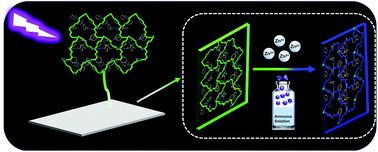Two luminescent film sensors constructed from new lanthanide coordination polymers for ratiometric detection of Zn2+ and NH3 in water and their white emission properties†
Abstract
To enrich the application of luminescent lanthanide coordination polymers, three 2D lanthanide coordination polymers, [EuL(NO3)3]n·2C4H8O2 (EuL), [TbL(NO3)3]n·2C4H8O2 (TbL) and [GdL(NO3)3]n·2C4H8O2 (GdL), which feature lumpy 2D networks with Ln3+ centres and the ligand L acting as three connected angular subunits, L = 2,2′-((2-((2-(benzylcarbamoyl)phenoxy)methyl)-2-(pyridin-4-yl) propane-1,3-diyl)bis(oxy))bis(N-benzylbenzamide), were prepared and well characterized. The excellent sensitizing properties of the ligand L to Eu3+ and Tb3+ were ascertained by both experimental and theoretical methods. To enhance the thermal stability, water resistance and luminescent performance for expanding their practical applications, spin-coated films of EuL/TbL and their poly(methylmethacrylate) (PMMA) hybrid congeners (EuL/TbL@PMMA) were prepared. The photophysical investigations on EuL/TbL@PMMA indicate that they could detect Zn2+ and NH3 in aqueous media in a ratiometric mode and could be used as efficient ratiometric film sensors for Zn2+ and NH3 with lower detection limits than those allowed by the World Health Organization or the threshold limit for ammonia in the workplace set by the Occupational Safety and Health Administration. The recognition mechanisms were disclosed by a combination of experiment and DFT calculation and the results indicate that the recognition of Zn2+ could be due to metal displacement while that for NH3 could be attributed to the modulation of the triplet energy level of the antenna in lanthanide coordination polymers induced by the hydrogen bonds between L and ammonia. In addition, EuL and EuL@PMMA could afford pure white emissions with CIE coordinates of (0.33, 0.33) and (0.33, 0.32) upon excitation at 334 nm and 275 nm, respectively. The results presented herein not only enrich the ratiometric detection arsenal for Zn2+ and NH3 but also provide some support for the development of white emission film materials.



 Please wait while we load your content...
Please wait while we load your content...